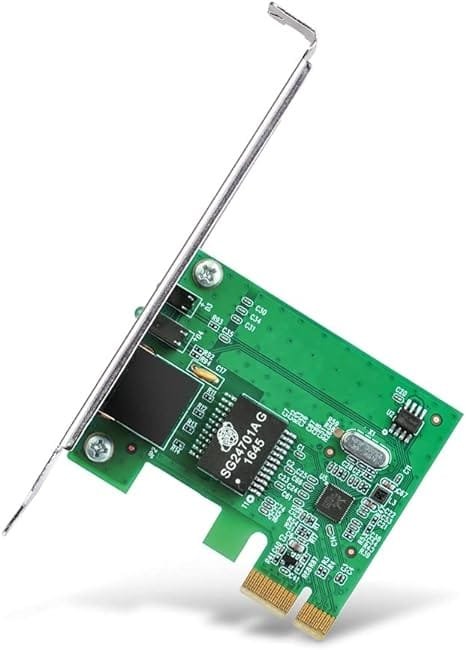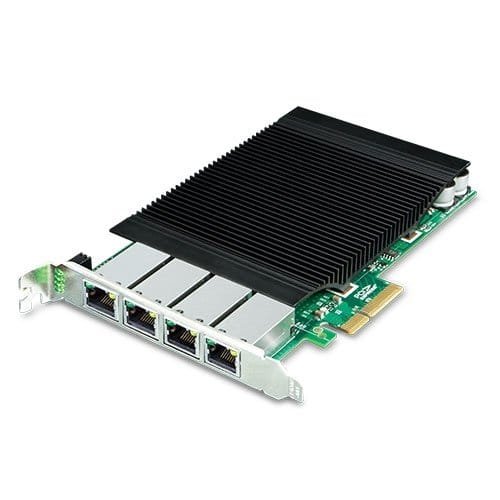ICT Accessories
What is a Network Interface Card (NIC)
A Network Interface Card (NIC), also known as a network adapter or network interface controller. It is a hardware component that allows a computer or other device to connect to a network. In simple terms it is the device that serves as the interface between the device and the network medium. Therefore, enabling communication by transmitting and receiving data packets.

The Network Interface Card (NIC) provides a computer with a dedicated, full-time connection to a network. It implements the physical layer circuitry necessary for communicating with a data link layer standard, such as Ethernet or Wi-Fi. Each card represents a device and can prepare, transmit and control the flow of data on the network.
Components of a Network Interface Card (NIC).
The Network Interface Card (NIC), uses the Open System Interconnection (OSI) model to send signals at the physical layer. Transmit data packets at the network layer and operate as an interface at the TCP/IP layer.
A NIC typically consists of the following components:
Physical Interface
This is the physical connection point between the NIC and the network medium. It may include ports such as Ethernet ports (e.g., RJ-45 connectors) for wired connections or wireless antennas for wireless connections.
Ethernet Controller
The Ethernet controller is the main processing unit of the NIC, responsible for managing data transmission and reception. It handles tasks such as packet encapsulation and decapsulation, error detection and correction, and interfacing with the device’s operating system.
Memory Buffer
A small onboard memory buffer or cache is often included in the NIC. It temporarily stores incoming and outgoing data packets. This buffer helps to smooth out fluctuations in network traffic and optimize performance by reducing latency and packet loss.
LED indicator
Most NICs have an LED indicator integrated into the connector. To notify the user when the network connects and data transmission occurs
Driver Software
The NIC requires software drivers to interface with the device’s operating system and network protocols. These drivers provide a standardized interface for configuring and managing the NIC. As well as handling communication tasks such as packet routing and protocol conversion.
Understanding NIC
Network Interface Cards play a critical role in enabling devices to communicate and exchange data over networks. Making them essential components in modern computing infrastructure. They are commonly found in desktop computers, laptops, servers, routers, switches. And other networked devices across a wide range of industries and applications.
NICs come in various forms and configurations to support different types of network connections, including:
Ethernet NICs: These are the most common type of NICs and support Ethernet-based networking technologies, such as 10/100/1000 Gigabit Ethernet (GbE) or 10/25/40/100 Gigabit Ethernet (10/25/40/100 GbE).
Wireless NICs: Also known as Wi-Fi adapters, these NICs enable wireless connectivity to Wi-Fi networks using IEEE 802.11 standards. They typically include built-in antennas for transmitting and receiving radio signals.
USB NICs: These types of NICs provide network connections through a device plugged into the USB port.
Fibre Optic NICs: These NICs are designed for high-speed storage area networks (SANs) and support Fibre Channel protocols for connecting to storage devices such as SAN switches and storage arrays.
Applications of NIC.
Network Interface Cards (NICs) find applications across various industries and sectors, playing a crucial role in facilitating communication between computers and networks. Here are some key applications:
Enterprise Networking
NICs are essential components in enterprise networking environments, enabling computers and servers to connect to local area networks (LANs) and wide area networks (WANs). They facilitate the exchange of data, access to shared resources such as printers and servers, and communication between networked devices within an organization.
Data Centers
In data center environments, high-performance NICs are used to interconnect servers, storage systems, and networking equipment, enabling efficient data transfer and communication between computing resources. NICs support technologies such as Ethernet, Fibre Channel over Ethernet (FCoE), and InfiniBand to meet the bandwidth and latency requirements of modern data center applications.
Cloud Computing
NICs play a crucial role in cloud computing platforms, enabling virtual machines (VMs) and cloud-based services to communicate with each other and with external networks over the internet or private connections. NICs support virtualization technologies such as SR-IOV (Single Root I/O Virtualization) and VMQ (Virtual Machine Queue) to optimize network performance in virtualized environments.
Telecommunications
In telecommunications networks, NICs are used in devices such as routers, switches, and gateways to enable voice, data, and multimedia services. NICs support protocols such as TCP/IP (Transmission Control Protocol/Internet Protocol) and SIP (Session Initiation Protocol) to facilitate communication over IP-based networks.
Industrial Automation
NICs are deployed in industrial control systems and automation networks to enable real-time monitoring, control, and data acquisition in manufacturing, utilities, transportation, and other industrial sectors. NICs support industrial protocols such as Modbus, Profibus, and EtherNet/IP to interface with industrial devices and sensors.
Internet of Things (IoT)
In IoT applications, NICs are used in connected devices such as sensors, actuators, and gateways to enable communication with other devices and cloud-based services. NICs support wireless technologies such as Wi-Fi, Bluetooth, Zigbee, and LoRaWAN to connect IoT devices to the internet and local networks.
Military and Defense
NICs are deployed in military and defense applications for secure communication and data transfer in tactical and strategic environments. NICs support encryption and authentication protocols such as IPsec (Internet Protocol Security) and AES (Advanced Encryption Standard) to protect sensitive information and ensure operational security.
Consumer Electronics
The NICs are integrated into consumer electronics devices such as desktop computers, laptops, smartphone. Also smart TVs to enable internet connectivity and access to online services. NICs support wireless technologies such as Wi-Fi, Bluetooth, and NFC (Near Field Communication) to provide wireless connectivity in consumer devices.
Conclusion:
Overall, the future of Network Interface Cards (NICs) is likely to be characterized by higher speeds, lower latency, enhanced security, and greater intelligence. Enabling the NICs to actually meet the evolving demands of modern networking infrastructure and drive innovation in connectivity and communication technologies.

